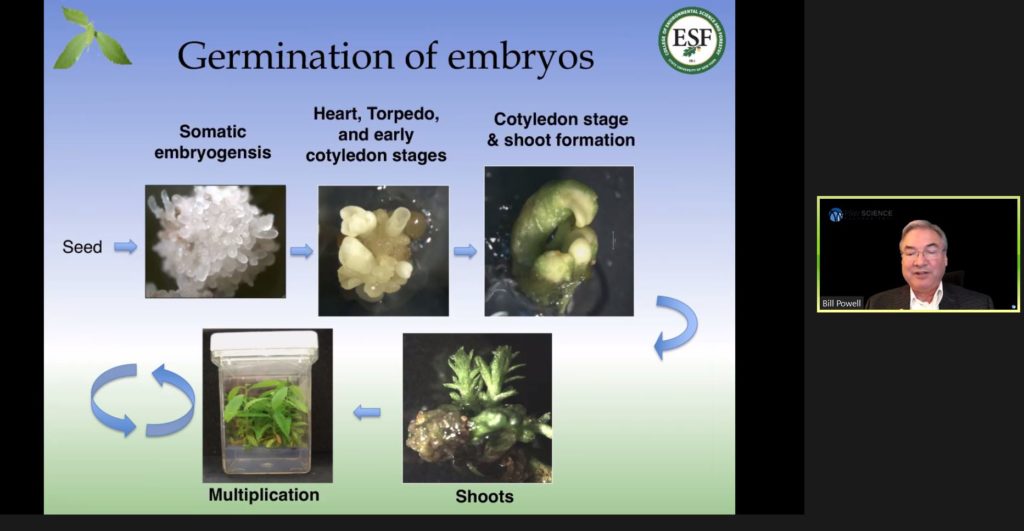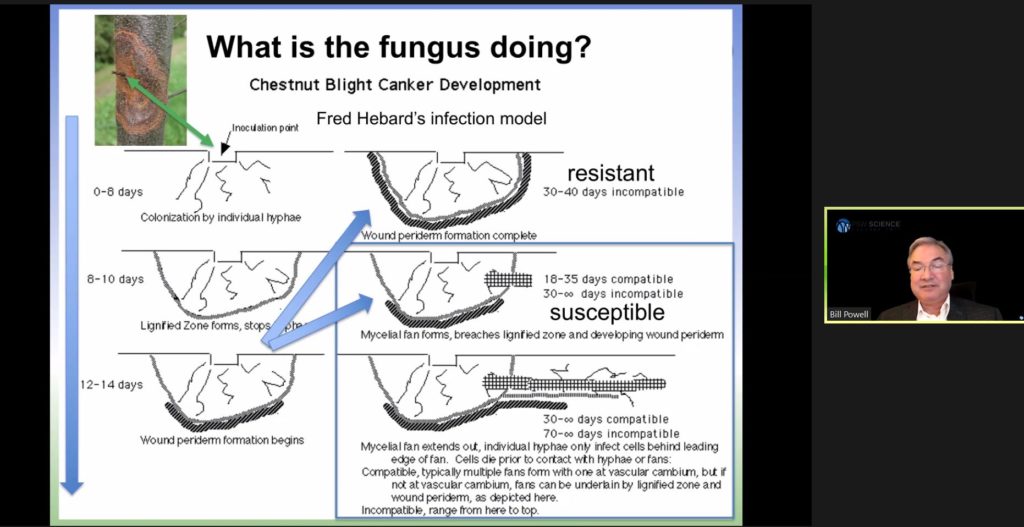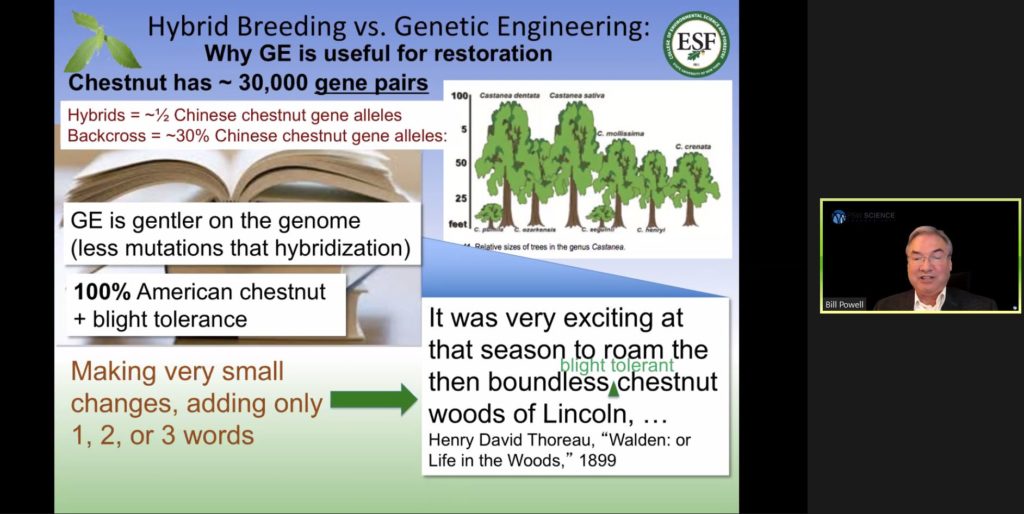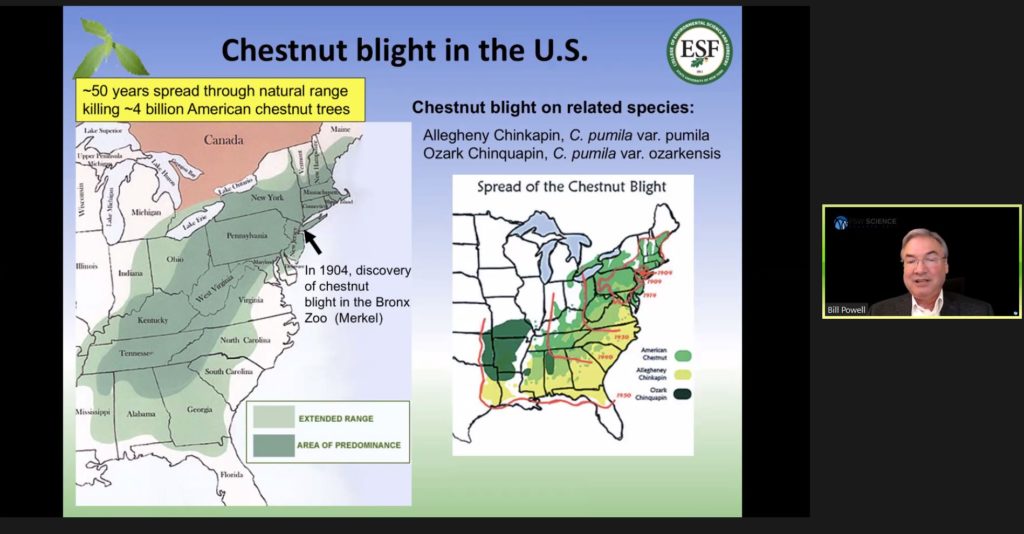Bringing Back the American Chestnut Tree
How Biotechnology Can Be Applied to Conservation
William A. Powell
Director, American Chestnut Research & Restoration Project
Roosevelt Wild Life Station Scientist-in-Residence
Sponsored by PSW Science Member Tim Thomas
About the Lecture
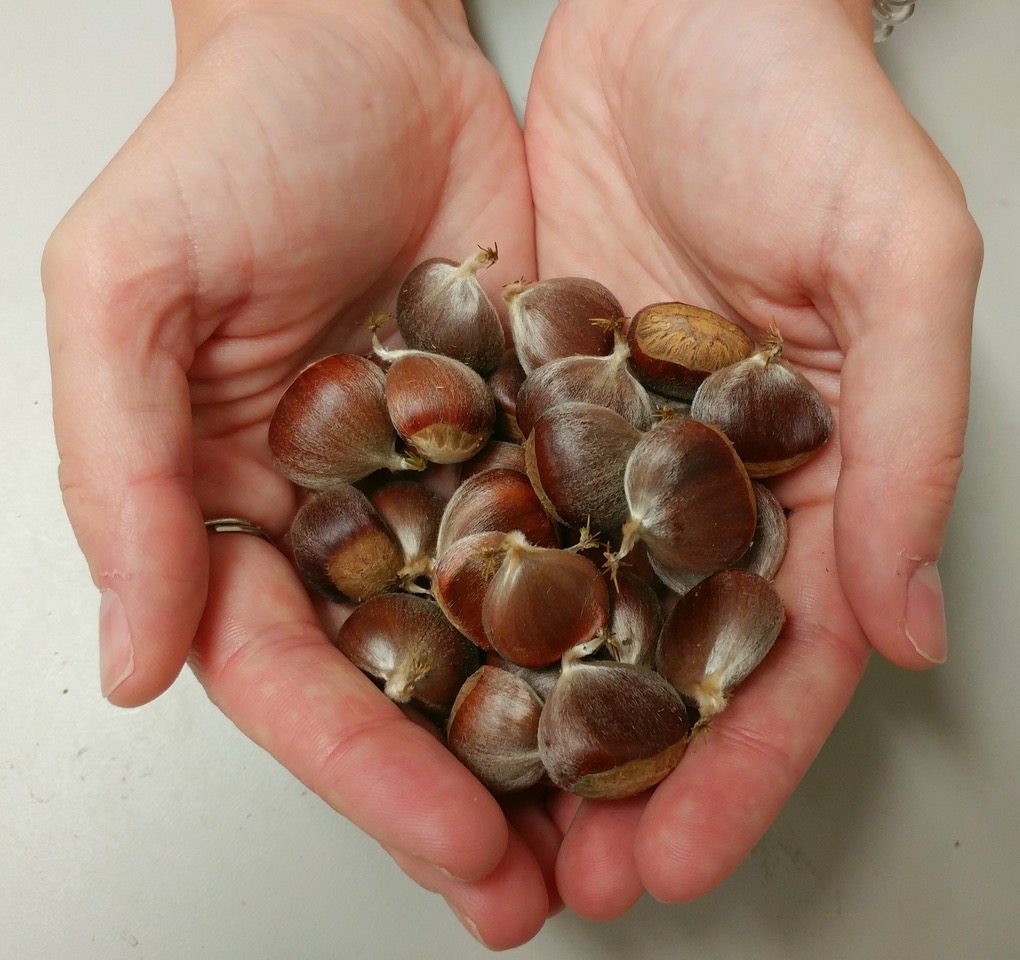
The American chestnut (Castanea dentata) and chestnut blight is the classic example of what can happen when forests succumb to invasive pests and pathogens. Because of its environmental, economic, and cultural importance, many tools have been brought to bear on the chestnut blight problem over the past century.
Our team has focused on genetic engineering approaches to enhancing blight tolerance, involving the targeted addition of specific genes to confer tolerance to the chestnut genome. All 38,000 naturally occurring genes remain the same, maintaining the full genetic complement required for growth and adaptation to the chestnut’s natural forest ecosystem.
The most promising gene tested to date encodes an oxalate detoxifying enzyme (oxalate oxidase, “OXO”), from the bread wheat, Triticum aestivum. The OXO gene is found in many plants, where it plays a role in defense against parasites. We found that this gene can confer enhanced blight tolerance in the American chestnut. The original blight tolerant trees grown with the OXO genes have not been outcrossed to susceptible American chestnut trees through three generations to date, increasing genetic diversity and local adaptation. Environmental impact experiments have been completed and these trees are currently under federal review before being released to the public and to restoration programs. This presentation will describe the program and its current progress toward restoring this keystone species and very beautiful tree to its native place in America’s forests.
Bibliography
Newhouse AE, Powell WA. Intentional introgression of a blight tolerance transgene to rescue the remnant population of American chestnut. Conservation Science and Practice. 2020;e348. https://conbio.onlinelibrary.wiley.com/doi/full/10.1111/csp2.348
McGuigan, Linda, Patrícia Fernandes, Allison Oakes, Kristen Stewart, and William Powell. 2020. “Transformation of American Chestnut (Castanea Dentata (Marsh.) Borkh) Using RITA® Temporary Immersion Bioreactors and We Vitro Containers.” Forests 11: 1196. https://doi.org/10.3390/f11111196
Powell WA, Newhouse AE, Coffey V. 2019. Developing blight-tolerant American chestnut trees., In Perspectives on Engineering Plant for Agriculture, P. Arnold Editor, Cold Spring Harb Perspect Biol, doi:10.1101/cshperspect.a034587 https://www.esf.edu/chestnut/documents/Cold%20Spring%20Harb%20Perspect.pdf
Goldspiel, H. B., Newhouse, A. E., Powell, W. A., & Gibbs, J. P. (2019). Effects of transgenic American chestnut leaf litter on growth and survival of wood frog larvae. Restoration Ecology, 27:371-378 https://doi.org/10.1111/rec.12879
Chestnut project video: https://www.youtube.com/watch?time_continue=4&v=-mhMdUryolU&feature=emb_logo
About the Speaker
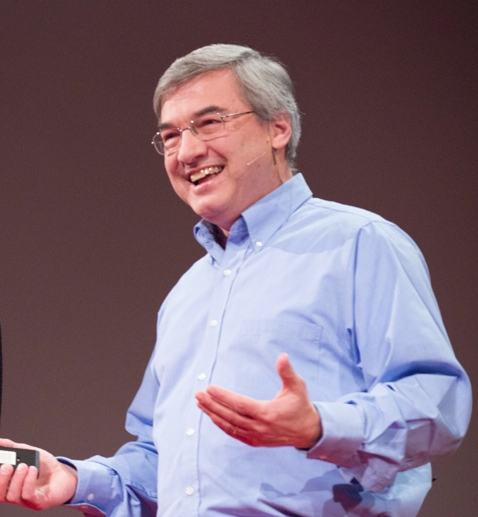
Bill Powell is Professor of Environmental Science and Forestry at the SUNY College of Environmental Sciences and Forestry, where he is Director of the American Chestnut Research & Restoration Project, and Scientist-in-Residence at the Roosevelt Wild Life Station.
Bill’s research focuses on the American Chestnut tree and the chestnut blight pathogen that has driven it almost to extinction. He has studied the hypovirulence mechanisms of the fungus and has used classical and molecular genetic techniques to develop blight tolerant chestnut trees.
Bill has published widely on his work.
Among other honors and awards, Bill was named Forest Biotechnologist of the Year by the Institute of Forest Biotechnology. He received the Exemplary Researcher Award bestowed by SUNY-ESF and the SUNY Chancellor’s Award for Research and Scholarship.
Bill earned a BS in Biology at Salisbury State University and a PhD in Biology at Utah State University.
Minutes
On May 21, 2021, by Zoom webinar broadcast on the PSW Science YouTube channel, President Larry Millstein called the 2,441st meeting of the Society to order at 8:02 p.m. EDT. He welcomed new members, and the Recording Secretary read the minutes of the previous meeting.
President Millstein then introduced the speaker for the evening, Bill Powell, Professor of Environmental Sciences and Forestry at the State University of New York, and Director of the American Chestnut Research and Restoration Project. His lecture was titled, “Bringing Back the American Chestnut Tree: How Biotechnology Can Be Applied to Conservation.”
In the 19th century, there were over three billion American chestnut trees in eastern North America, comprising approximately 25% of the trees in the Appalachian Mountains. Among the largest trees in the Eastern forests, American chestnuts were widely used for woodworking, food and beer production, and medicinal purposes. Animals, from bees to bears, also relied on the American chestnut.
In the early 20th century, Asian chestnut trees were imported into the United States and brought with them cryphonectria parasitica. American chestnut trees were vulnerable to the invasive fungus, and died off in droves. Within 50 years, the blight killed approximately 4 billion American chestnut trees in the Eastern United States.
Because the fungus continues to survive on oak trees, Powell said it prevents a natural American chestnut resurgence. Yet, despite the blight, American chestnut trees are not extinct. Rootstock continues to survive across American forests because the blight cannot compete with microorganisms in soil. These roots at times go through a Sisyphean cycle of sprouting, becoming infected with blight, and dying back again.
During the great die-off, public efforts to defeat the blight included fungicides, removing infected trees, replacing American chestnut trees with non-native “timber-type” Chinese chestnut trees, gamma and x-ray mutagenesis, and hypovirulence. Continuing efforts include species hybrid breeding, backcross breeding of hybrids, and genetic engineering.
Powell said chestnut hybrids are suitable for ornamental and crop purposes, but not for restoration. Hybrid chestnut trees are prone to reduced growth, male sterility, cracked bark, and loss of desired traits in future generations. These problems can be managed in an agricultural setting, but are fatal to restoration in the wild.
In 1983, the American Chestnut Foundation began with a hybrid and back-crossed it with pure American chestnuts through several generations to select for the American phenotype with the blight resistance of Asian species. Since then, the Foundation’s efforts have produced American chestnut phenotypes with only intermediate blight resistance.
Chestnut has approximately 30,000 gene pairs. Genetic engineering allows scientists to begin with an American chestnut tree and add only genetic coding for blight resistance.
When the blight enters a tree wound, it forms an individual hyphae in the wound and lives off dead material. Both the American and Chinese chestnut will respond by laying down a lignified zone to try and “wall off” the fungus. The trees will then form vascular tissue and slough off the canker. But, in susceptible trees, the fungus forms mycellal fans that excrete acids and break through the lignified barrier.
Some trees have developed the ability to release oxalate oxidase, polygalacturonase-inhibiting proteins, and laccase-like genes to counter the blight’s attacks. Powell described the various resistance genes scientists have investigated and selected for encoding into American chestnut trees. He said these efforts are currently in early stages.
Laccases have been shown to increase resistance in plants like cotton by increasing lignification. Laccases are similar in both American and Chinese chestnut, but Chinese chestnut expresses them tenfold. Powell said scientists are now exploring methods like CRISPR to encode genetic “promoters” from the Chinese species into the American chestnut to enhance laccase expression.
Scientists are currently working on the gene that encodes the oxalate oxidase enzyme. While the non-gluten, non-allergen enzyme is found in many food crops, Powell’s organization is focused on the wheat variety. If successful, the American chestnut will be able to detoxify oxalic acid and fend off the blight without killing the fungus.
Powell then described the agrobacterium process for inserting genes into individual cells. His team has shortened the process to 12 months, from transformation to a potted American chestnut plant.
Because genes are inserted semi-randomly into a chromosome, scientists need to test numerous events to identify optimal results. Scientists then use leaf and stem assays to assess blight resistance.
To begin outcrossing resistant trees, Powell’s team uses a light chamber to induce flowering in transgenic trees to pollinate wild-type American chestnuts. They have so far proven that oxalate oxidase is passed to offspring.
Powell then addressed the EPA, USDA, and FDA regulatory framework and the minimal adverse environmental impact of his work.
Powell is optimistic that genetic engineering will facilitate restoring the American chestnut in the wild. He sees planting in mine reclamation sites, historic sites, and on private land, initiating a 100-year process to restore the American chestnut to the wild.
After the question and answer period, President Millstein thanked the speaker, made the usual housekeeping announcements, and invited guests to join the Society. President Millstein adjourned the meeting at 9:56 p.m.
Temperature in Washington, D.C.: 26° C
Weather: Sunny
Concurrent Viewers of the Zoom and YouTube live stream, 51 and views on the PSW Science YouTube and Vimeo channels: 245.
Respectfully submitted,
James Heelan, Recording Secretary
Highlights
